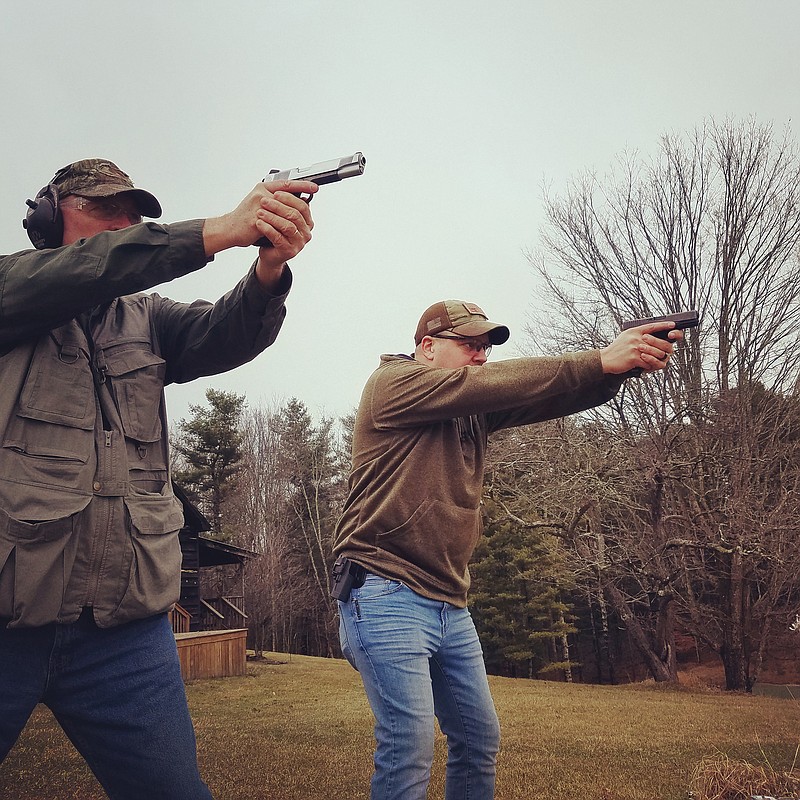Some people like to argue. You know this is true, and you know people who do it. Maybe you are one of them.
I know some people who are so argumentative, I've told them I would go out in the woods, find them a tree stump and bring it back so they could argue with it. You know the type. Back in the day, the "motorhead" car crowd loved to argue about the merits of Fords and Chevys, and I guess that debate is still going on today.
I have always thought some people in the world of firearms can be very opinionated. One of the most talked-about, discussed, cussed and fought-over topics is the Model 1911-style pistol versus the Glock. The world of guns has beaten this dead horse until it is mostly dust.
For a quick review, the semiautomatic pistol that became known as the 1911 is the brainchild of John Moses Browning, a gun-inventing genius who gave us dozens of well-known firearms, including the Browning A-5 shotgun. The 1911 was conceived by Browning and included in testing because the military was looking for a more substantial sidearm for our troops and it was chambered in the .45 Automatic Colt Pistol. The weapon carried at the time, the .38 revolver, was considered inadequate by soldiers engaged in combat with the Moro tribesmen in the Philippines. (For more on this, see "Thoughts on Mr. Browning's Pistol" at my website, gunsandcornbread.com.)
The 1911 .45 was the issued sidearm for our military through two World Wars, Korea and Vietnam, and some specialized units still use it today.
The Glock pistol has quite a different background. The inventor, Austria's Gaston Glock, had never engineered a firearm prior to 1980, when the Austrian military announced it was seeking designs for a new sidearm to replace the Walther P38. Glock quickly assembled a team of firearms experts and delivered the Glock 17, which beat out several other pistol companies in the subsequent testing, including Berretta, FN, Heckler & Koch and SIG Sauer.
It became the issued sidearm for the Austrian military, and many other countries followed.
The Glock was very revolutionary at time by being a striker-fired pistol (in contrast to the hammer-fired 1911), which means there is an internal mechanism to strike the round of ammunition to make it fire, which differs from the hammer-and-firing-pin system of the 1911. The Glock does not have an external hammer (as the 1911 does), and many believe this makes the weapon better for concealed carrying because it is less likely to snag on clothing.
What really caused the Glock to raise eyebrows and the 1911 fans to gnash their teeth was the Glock 17 is not an all-metal gun. The slide on the Glock pistol is metal; the frame is a high-strength, nylon-based polymer. To the old-school 1911 followers, this was heresy.
Volumes have been written in magazines and websites by loyal 1911 followers condemning the Glock for being a plastic (which it is not) gun that is a piece of junk. This issue has paid the rent for more than one guns writer. Then there is the issue of the safeties on these guns, another good debate.
Browning's design for the 1911 included two safeties that must be disengaged for the weapon to fire. One is the grip safety, which is deactivated when the shooter grasps the weapon; the other is a manual safety that is pressed downward with the thumb by a right-handed shooter. Loyalists to the 1911 insist this makes the pistol safe to handle, while Glock advocates say this makes the 1911 too complicated, with too many buttons to push and too many things to go wrong in high-stress situations.
The Glock has built-in safety features for its trigger and inner mechanism - indeed, the company named it the "Safe Action" trigger. Have there been accidental or negligent (they are different) discharges with a Glock pistol? Absolutely. Has the same thing happened with 1911-style guns? You bet! You will find that most of the time when a firearm goes off when it shouldn't, it is the fault of the shooter, not the gun.
Where do I land on this all this? You're going to say I'm riding the fence, but I like both.
I'm a former officer in the West Virginia Department of Natural Resources, and when my department converted to the Glock for a duty gun, I was one of the old heads who griped about it. I said this gun is really ugly - that's another thing 1911 fans say about the Glock - it's plastic and it's just a cheaply made piece of junk. I then watched as our officers took the Glock, went to the range and shot better than I had seen them shoot before.
I like the Glock because it goes bang every time I pick it up and pull the trigger. This is job No. 1 any handgun must accomplish before I will have anything to do with it. For a self-defense handgun, I also prefer no manual safeties to worry about when things get real.
Right about now, the 1911 devotees are ripping the paper and spilling coffee. Guys, I understand. I have owned and shot 1911-style pistols, and they are great guns. As with many things in life, this issue is a matter of personal preference.
If you like the 1911 Colt .45 ACP, carry it in good health. If you would rather pack a Glock pistol with 18 rounds in it, more power to you.
Now that we have that over with, let's argue about something important - such as the best caliber to deer hunt with, or if your Uncle Ed really did see a mountain lion last week.
"The Trail Less Traveled" is written by Larry Case, who lives in Fayette County, W.Va. You can write to him at larry ocase3@gmail.com.

